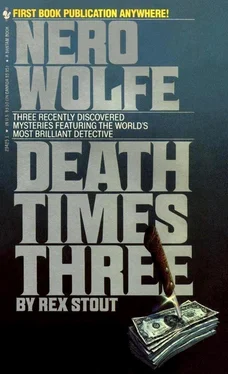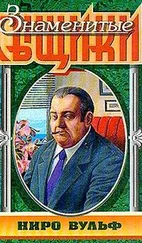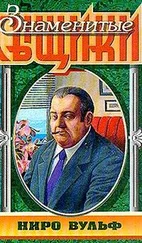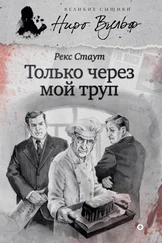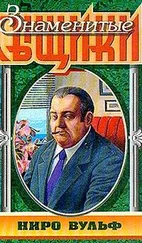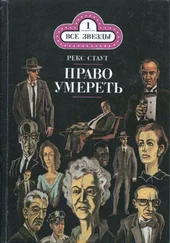In “Frame-Up for Murder” we must begin all over with Flora. She first catches Archie’s eye in the lobby of the Churchill “because she rated a glance as a matter of principle — the principle that a man owes it to his eyes to let them rest on attractive objects when there are any around.” Her chin was, Archie acknowledged, “slightly more pointed than I would have specified if I had had her made to order,” but otherwise her ranking is high among the women who have intrigued Archie Goodwin over the years. A shoulder spread of mink, a floppy-brimmed hat, which is at Archie’s ear level — so that, as he notes, her hair might graze his chin if she removed it — and a trace of a beguiling foreign accent, are all that this Flora needs, in addition to her beauty, to intrigue Archie. When she accosts him on the uptown side of Thirty-eighth Street, he confesses, “If she had been something commonplace like a glamorous movie star,” he might have gone on his way without further interest. But that does not happen. Flora’s game is to get to know Archie so that he will gain her an audience with Nero Wolfe. She dines with him and dances with him to assure the success of this stratagem. Her kisses are prologue to inquisitions. Yet, she is naively obvious in her intrigues, and Archie, never for a moment taken in, finds her simple, obvious machinations (embarked on for no more sinister a purpose than to protect her brother and his business) a source of unmitigated delight. This new Flora burgeons in the opening pages of “Frame-up for Murder.” Her subsequent pursuit of Archie through the streets of Manhattan and her success in bringing him down, on the wing, so to speak, stirs our interest in a way that totally eclipses the opening of “Murder Is No Joke.”
Rex Stout enjoyed portraying beautiful foreign women of fierce integrity whose hearts are set on realizing some laudable goal that they pursue with a tenacity that gives consequence to their obvious ploys when they try to enlist the services of those who can get them the results they want. In his beautiful wife, the Polish-born Pola Hoffman, their friends recognized the prototype of these women. Here, in a story set in the world of high fashion, the identification is more easily made, for Pola Stout was one of America’s foremost designers of woolen fabrics and her fabrics were much in favor with top fashion houses both in the United States and Europe. It was Pola’s calling that gave Rex the setting and plot for several other stories, most notably The Red Box and Red Threads , and made him always attentive to the clothes his characters were wearing.
In “Murder Is No Joke,” Flora Gallant offers Nero Wolfe a hundred dollars as a retainer. In “Frame-Up for Murder,” as befits her upgraded status, the sum increases to three hundred, still not a princely offering from someone swathed in mink, but enough, Archie says, either to pay his salary for two days or to keep Wolfe in beer for three weeks. That Archie has mellowed toward Flora since her transformation from frog to princess is evident. In “Murder Is No Joke” he had calculated that her hundred-dollar deposit would, at most, buy beer for Wolfe for four days. But more than pecuniary advantages attach to Flora’s new appearance. Her metamorphosis generated most of the new pages that expanded “Murder Is No Joke” from forty-eight pages to seventy-nine. In “Murder Is No Joke,” after murder was committed it was not worth anyone’s bother to bring Flora on the scene when Archie visited the offices of Gallant, Inc., to interview the chief suspects. In “Frame-Up for Murder” Flora is prominently visible, and her presence makes Archie’s day. At the close of this interlude, moreover, Archie struts into Alec Gallant’s office and speaks his mind with a bravado remarkable even for Archie. One has to assume that his recent smooching with Flora has produced such a rush of adrenaline that he is ready to take on the world. Perhaps that also accounts for his boast to Emmy Thorne that he can chin himself twenty times.
Nero Wolfe likewise appears to better advantage in the rewrite of “Murder Is No Joke,” and not solely because a younger, demure Flora declines to speculate in jaded tones on his sex life. A vital Flora generates more excitement all around. Archie cares more about the case that evolves out of her visit to the brownstone, and so, inevitably, does Wolfe. Wolfe’s speculations concerning the authenticity of the phone call made to Bianca Voss come forth more promptly and do not seem, as in “Murder Is No Joke,” arrived at through the instigation of Inspector Cramer. The lively exchange of comments between Wolfe and Archie when Bianca’s visit ends is also one of the high moments of the rewrite since it has no counterpart in “Murder Is No Joke.” One detects, too, that, once drawn into the case, Wolfe becomes, on learning of Alec Gallant’s resistance activities in World War II, allied to him in sympathies. Certainly Rex’s own commitments in the war years assured both his allegiance to Gallant’s principles and his tacit approval of Gallant’s initiative taken when the niceties of the law raised the possibility that heinous crimes against humanity would go unpunished.
At one point in “Murder Is No Joke,” Nero Wolfe is grossly insulted. He is told, “ ‘You are scum, I know, in your stinking sewer! Your slimy little ego in your big gob of fat!’ ” Even Cramer is nonplussed when these phrases are repeated to him. It is easier to believe that the drab and hostile Flora scripted these lines in “Murder Is No Joke” than to attribute them to the vivacious Flora of “Frame-Up for Murder.” But happily they survived the rewrite, and that kept in the marvelous scene in which Wolfe shows how the word “gob” made him aware that “the extraordinary billingsgate... spat at me” was a prepared text. To know the words were spoken only for calculated effect makes everyone feel better — Wolfe as well as the reader. And, really, we could not spare that moment when, after Wolfe’s explanation is forthcoming and he gestures at the conclusion, Archie complacently observes, “He waved ‘gob’ away.”
In “Frame-Up for Murder,” Inspector Cramer is given more to do than he was given in “Murder Is No Joke.” We may commend him, perhaps, for his restraint in not pointing out that this attempt to deceive Wolfe repeats an episode from The Rubber Band . Perhaps it was Cramer’s prudence on this occasion that induced Rex Stout to allow him to speak the words “Murder is no joke,” which gave the story its title and accounts, as well, for Wolfe’s generous reiteration of these words at a crucial moment in the story. It is surprising to observe, in scrutinizing the original manuscript, that Rex Stout once marked these words for excision. It is more surprising yet, to discover from his notes that originally he had settled on a different murderer. No harm can come from mentioning the name now, because no reasonable reader will see him as a possible suspect. We are referring to Carl Drew! It was a good day’s work when Rex changed his mind.
While odd circumstances attended the writing of “Bitter End” and “Frame-Up for Murder,” the history of one other Wolfe novella is even more unusual — that is, the story serialized as “The Counterfeiter’s Knife” in The Saturday Evening Post , in the issues for January 14, 21, and 28, 1961. Unaltered, the same story was published the following year as “Counterfeit for Murder” in Homicide Trinity , one of the tripartite Wolfe volumes. Rex’s Writing Record for this story reads: “73 pp. Began 3/6/59, finished 3/31/59. 9 days out, 17 days writing time.” His breakdown of days shows that he actually worked on it on twenty-three different days, but sometimes only for short intervals, which he recorded as fractions of days. Only on the nineteenth and twentieth, when he was in New York, and on the twenty-ninth, Easter Sunday, was he away from his desk entirely. For Rex to give so much time to a single novella was unusual. But we do not have to look far for an explanation. As he noted in his Writing Record, underlining the word twice for emphasis, the story he wrote in that twenty-six-day interval was a “Rewrite.” Just ahead of the entry given above he had recorded these particulars concerning the original version of the story: “ ‘Counterfeit for Murder’ — 74 pp. Began 1/22/59, finished 2/11/59. 3 days out, 18 days writing time.” Only on two days did he do no writing at all, the twenty-ninth and thirtieth of January, when he had to be in Providence. Fractions of days show that he could have reduced the total of working days by another three, making, in all, five days out. But, all things considered, the work had gone well; so that, quite up to his usual average, he had written four or five pages on twelve of the nineteen days he had written. Nothing in his notes suggests that he was dissatisfied with the results. Yet, less than a month later, he discarded all but the first seven pages of this story and, starting again at that point, took events in a direction so contrary to that in which they had moved before, that the lady who quickened Archie’s heartbeat in the original is here hastily dispatched with a bread knife, and the dowdy boardinghouse keeper, who had promptly fallen prey to a hit-and-run motorist in the first version, here escapes with a grazing, is reanimated, and given liberty to engage Wolfe as well as Archie in some of the liveliest dialogue to be found anywhere in the corpus. She, Anthony Boucher said of Miss Hattie Annis, “is the most entertaining client to visit West Thirty-fifth Street in some time.” And indeed she was.
Читать дальше
